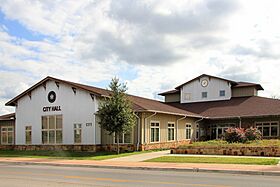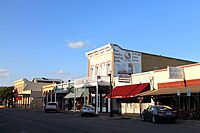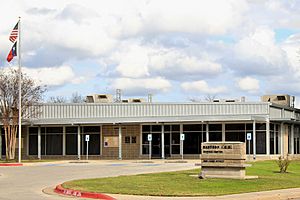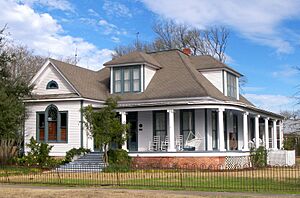Bastrop, Texas facts for kids
Quick facts for kids
Bastrop, Texas
|
|
|---|---|

Bastrop City Hall
|
|
| Nicknames:
The Most Historic Small Town in Texas;
Heart of the Lost Pines |
|
| Country | United States |
| State | Texas |
| County | Bastrop |
| Incorporated | December 18, 1837 |
| Area | |
| • Total | 9.34 sq mi (24.20 km2) |
| • Land | 9.22 sq mi (23.89 km2) |
| • Water | 0.12 sq mi (0.31 km2) |
| Elevation | 367 ft (112 m) |
| Population
(2020)
|
|
| • Total | 9,688 |
| • Density | 1,001.95/sq mi (386.87/km2) |
| Time zone | UTC-6 (Central (CST)) |
| • Summer (DST) | UTC-5 (CDT) |
| ZIP code |
78602
|
| Area codes | 512, 737 |
| FIPS code | 48-05864 |
| GNIS feature ID | 2409795 |
Bastrop is a city in Texas, United States. It is the main city, or county seat, of Bastrop County. In 2020, about 9,688 people lived there.
Bastrop is located about 30 miles (48 km) southeast of Austin. It is part of the larger Austin metropolitan area.
Contents
History of Bastrop
Spanish soldiers first stayed in the area where Bastrop is now in 1804. They built a fort called Puesta del Colorado where the Old San Antonio Road crossed the Colorado River.
The city of Bastrop is named after Felipe Enrique Neri, Baron de Bastrop. He was a man from the Netherlands who helped Moses and Stephen F. Austin get land in Texas. He also worked as Austin's land commissioner.
In 1827, Stephen F. Austin helped about 100 families settle in this area. Austin asked Mexican officials to name a new town after the baron, who passed away that same year.
On June 8, 1832, the town was officially planned out. It had a central square and areas set aside for public buildings. It was named Bastrop. However, two years later, the government of Coahuila y Tejas changed the name to Mina. This was to honor Francisco Javier Mina, a Mexican hero who died fighting for his beliefs.
On December 18, 1837, the town became an official city under the laws of the Republic of Texas. Its name was then changed back to Bastrop.
The Lost Pines Forest
Overlooking the center of Bastrop is the Lost Pines Forest. This forest is made up of loblolly pines. It's special because it's the westernmost part of the large southern pine forest.
Since it was the only timber available nearby, the forest was very important for the local economy. Bastrop started providing wood to Austin in 1839. Later, it supplied wood to San Antonio, other parts of western Texas, and even parts of Mexico.
Fires and Historic Buildings
In 1862, a big fire destroyed most of Bastrop's downtown shops and the county courthouse. Because of this, most of the buildings you see downtown today were built after the Civil War.
In 1979, 131 buildings and sites in Bastrop were added to the National Register of Historic Places. This honor helped Bastrop earn the nickname "The Most Historic Small Town in Texas."
Local News
The first newspaper in Bastrop, the Bastrop Advertiser and County News, was published on March 1, 1853. This makes it one of the oldest newspapers in Texas that has been published continuously.
The 2011 Wildfire
On September 4, 2011, two large wildfires started when trees fell onto power lines. The fires grew and joined together, creating the Bastrop County Complex fire.
This was the worst wildfire in Texas history. It destroyed 1,691 homes and caused a lot of damage. Strong winds from Tropical Storm Lee and a drought in Texas made the fire worse.
Geography and Climate
Bastrop is located in the middle of Bastrop County, along the lower Colorado River. The main business area is on a hill on the east side of the river. However, the city also extends to the west side of the river.
The city covers about 9.34 square miles (24.20 square kilometers). Most of this area is land, with a small part covered by water.
Lake Bastrop
About 3 miles (5 km) northeast of Bastrop is Lake Bastrop. This is a 906-acre (3.67 km²) lake that was created in 1964. It is mainly used to cool a power plant, but it's also a popular spot for fun activities. The Lower Colorado River Authority (LCRA) manages two public parks on the lake.
Weather in Bastrop
Bastrop usually has cooler weather than other cities in central Texas. However, temperatures can still reach 100°F (38°C) in the summer. The lowest temperature ever recorded was -1°F (-18°C), and the highest was 111°F (44°C).
| Climate data for Bastrop, Texas | |||||||||||||
|---|---|---|---|---|---|---|---|---|---|---|---|---|---|
| Month | Jan | Feb | Mar | Apr | May | Jun | Jul | Aug | Sep | Oct | Nov | Dec | Year |
| Record high °F (°C) | 88 (31) |
96 (36) |
98 (37) |
102 (39) |
103 (39) |
106 (41) |
111 (44) |
110 (43) |
111 (44) |
105 (41) |
94 (34) |
91 (33) |
111 (44) |
| Mean daily maximum °F (°C) | 63 (17) |
66 (19) |
73 (23) |
80 (27) |
87 (31) |
92 (33) |
95 (35) |
97 (36) |
91 (33) |
83 (28) |
73 (23) |
64 (18) |
83 (28) |
| Mean daily minimum °F (°C) | 38 (3) |
41 (5) |
48 (9) |
56 (13) |
64 (18) |
70 (21) |
72 (22) |
72 (22) |
66 (19) |
56 (13) |
47 (8) |
39 (4) |
56 (13) |
| Record low °F (°C) | −1 (−18) |
6 (−14) |
17 (−8) |
25 (−4) |
38 (3) |
50 (10) |
52 (11) |
50 (10) |
43 (6) |
27 (−3) |
20 (−7) |
3 (−16) |
−1 (−18) |
| Average precipitation inches (mm) | 2.56 (65) |
2.54 (65) |
2.85 (72) |
2.65 (67) |
4.50 (114) |
3.66 (93) |
2.23 (57) |
2.19 (56) |
3.69 (94) |
4.82 (122) |
3.30 (84) |
2.72 (69) |
37.71 (958) |
| Source: weather.com | |||||||||||||
Population Information
| Historical population | |||
|---|---|---|---|
| Census | Pop. | %± | |
| 1860 | 1,107 | — | |
| 1870 | 1,199 | 8.3% | |
| 1880 | 1,546 | 28.9% | |
| 1890 | 1,634 | 5.7% | |
| 1900 | 2,145 | 31.3% | |
| 1910 | 1,707 | −20.4% | |
| 1920 | 1,828 | 7.1% | |
| 1930 | 1,895 | 3.7% | |
| 1940 | 1,976 | 4.3% | |
| 1950 | 3,176 | 60.7% | |
| 1960 | 3,001 | −5.5% | |
| 1970 | 3,112 | 3.7% | |
| 1980 | 3,789 | 21.8% | |
| 1990 | 4,044 | 6.7% | |
| 2000 | 5,340 | 32.0% | |
| 2010 | 7,218 | 35.2% | |
| 2020 | 9,688 | 34.2% | |
| U.S. Decennial Census | |||
2020 Census Data
| Race | Number | Percentage |
|---|---|---|
| White (NH) | 5,581 | 57.61% |
| Black or African American (NH) | 965 | 9.96% |
| Native American or Alaska Native (NH) | 35 | 0.36% |
| Asian (NH) | 228 | 2.35% |
| Pacific Islander (NH) | 15 | 0.15% |
| Some Other Race (NH) | 60 | 0.62% |
| Mixed/Multi-Racial (NH) | 392 | 4.05% |
| Hispanic or Latino | 2,412 | 24.9% |
| Total | 9,688 |
In 2020, the 2020 United States census counted 9,688 people living in Bastrop. There were 3,188 households and 2,022 families in the city.
Economy of Bastrop
As of 2020, the biggest employers in the Bastrop area are:
- The Bastrop Independent School District
- Hyatt Regency Lost Pines Resort and Spa
- The Bastrop County government
- MD Anderson Cancer Center
The Hyatt Regency Lost Pines Resort and Spa opened in 2006. It has 491 rooms and is located about 15 miles (24 km) west of Bastrop. This resort has created many jobs and boosted sales tax in the area. In 2011, it employed 600 people, plus 175 seasonal workers. This made it the largest private employer in Bastrop County.
Education in Bastrop
The Bastrop Independent School District (BISD) serves the students in Bastrop. Some students go to Mina Elementary School, while others go to Emile Elementary School.
All students in Bastrop attend Bastrop Intermediate School, Bastrop Middle School, and Bastrop High School.
Austin Community College offers night classes and continuing education at Bastrop High School.
From 1893 to 1969, Emile High School was a separate school for black students.
Famous People from Bastrop
Many interesting people have connections to Bastrop:
- Carolyn Banks, a writer of fiction
- Trent Brown, an offensive tackle for the New England Patriots in the NFL
- John Wheeler Bunton, an early Texas pioneer who signed the Texas Declaration of Independence
- Geoff Connor, a former Texas Secretary of State
- Greenleaf Fisk, a lawmaker in the Republic of Texas
- Louis Edwin Fry Sr., a former head of the architecture department at Howard University
- Ryan Holiday, an author
- Zachary Levi, an actor
- Richard Linklater, a director and writer
- Michael Moorcock, a science fiction and fantasy writer
- Thomas R. Phillips, a former Chief Justice of the Texas Supreme Court
- Billy Waugh, a former American Special Forces soldier and CIA officer
- Lovie Yancey, who founded the international burger chain Fatburger
Movies Filmed in Bastrop
Bastrop has been a popular location for filming movies! Here are some films that were at least partly shot there:
- Lovin' Molly (1974)
- The original The Texas Chain Saw Massacre (1974)
- Courage Under Fire (1996)
- Home Fries (1998)
- The 2004 remake of The Alamo
- All The Boys Love Mandy Lane (2006)
- Fireflies in the Garden (2008)
- The 2009 remake of Friday the 13th
- The Life of David Gale
- Michael
- Hope Floats (1998)
- True Women (1998 TV movie)
- The Tree of Life (2010)
- Bernie (2010)
- A Perfect World was filmed near Bastrop at the Buck Steiner Ranch.
- Joe Ransom was partly filmed at the Lost Pines Boy Scout Park in late 2012 and early 2013.
- Prince Avalanche (2013)
- Boyhood (2014) was filmed in the Lost Pines area of Bastrop.
See also
 In Spanish: Bastrop (Texas) para niños
In Spanish: Bastrop (Texas) para niños







